Intelligent Identification Method for the Diagenetic Facies of Tight Oil Reservoirs Based on Hybrid Intelligence—A Case Study of Fuyu Reservoir in Sanzhao Sag of Songliao Basin
Abstract
1. Introduction
2. Geological Setting
3. Diagenetic Facies Classification and Logging Response Analysis
3.1. Definition of Diagenetic Facies
3.2. Classification of Diagenetic Facies
3.3. Diagenetic Facies Logging Response Characteristics
4. C-ViTM Method
4.1. Logging Data Analysis
4.2. Establishment of the Diagenetic Facies Image Data Set
4.3. Processing of Imbalanced Data Sets
4.4. Design of Identification Model for the Diagenetic Facies of Tight Oil Reservoirs
4.5. Training of the Identification Model for the Diagenetic Facies of Tight Oil Reservoirs
5. Experimental Scheme
5.1. Experiment of the Identification Effect for Different Thickness Units
5.2. Accuracy Comparison Experiment
5.3. Single-Well Identification Effect Experiment
6. Results and Discussion
6.1. Experimental Results of the Identification Effect for Different Thickness Units
6.2. Accuracy Comparison Experiment Results
6.3. Experimental Results of the Single-Well Identification Effect
6.4. Application Prospect and Limitation Analysis of the C-ViTM Method in Diagenetic Facies Identification
7. Conclusions
- (1)
- Based on core data and logging response characteristics, the diagenetic facies of tight reservoirs of Fuyu reservoir in Sanzhao Sag were classified into seven types: Wip, Wap, Mip, Map, Msap, Mp, etc. The relationship between diagenetic facies and reservoir performance was established. Wip, Wap and Mip were classified as Class I reservoirs; Map and Msap were classified as Class II reservoirs; Mp was classified as a Class III reservoir. The reservoir performance was completed while realizing diagenetic facies identification.
- (2)
- By comparing the identification results of diagenetic facies at different thickness intervals of 0.50 m, 0.75 m, 1.00 m and 1.25 m, it was found that the best identification effect can be realized at the sample thickness of 0.50 m, indicating that the identification results are related to the thickness of various diagenetic facies and the thickness of sample intervals.
- (3)
- Compared with the single methods of CNN and ViT, C-ViTM has a better identification effect, with Precision of above 86%, Recall of above 90% and FI score of above 89%. The C-ViTM method is suitable for the identification of the diagenetic facies of tight reservoirs, but the identification effect is easily affected by the number of samples and the similarity of the internal structural features of diagenetic facies (the similarity of logging curve features), such as Wip and Mip.
- (4)
- The average Jaccard index calculated by using the C-ViTM method in diagenetic facies identification of a single well is 0.79, indicating that the C-ViTM method has a good identification effect and wide application prospects.
Author Contributions
Funding
Data Availability Statement
Conflicts of Interest
References
- Huang, L.; Yan, J.; Liu, M.; Zhang, Z.; Ye, S.; Zhang, F.; Zhong, G.; Wang, M.; Wang, J.; Geng, B. Diagenetic facies logging identification and application of deep tight sandstone gas reservoir: A case study of the third member of Xujiahe formation in Dayi area of western Sichuan depression. J. China Univ. Min. Technol. 2022, 51, 107–123. [Google Scholar]
- Lai, J.; Wang, G.; Wang, S.; Cao, J.; Li, M.; Pang, X.; Zhou, Z.; Fan, X.; Dai, Q.; Yang, L.; et al. Review of diagenetic facies in tight sandstones: Diagenesis, diagenetic minerals, and prediction via well logs. Earth-Sci. Rev. 2018, 185, 234–258. [Google Scholar] [CrossRef]
- Liu, F.; Wang, X.; Liu, Z.; Tian, F.; Zhao, Y.; Pan, G.; Peng, C.; Liu, T.; Zhao, L.; Zhang, K.; et al. Identification of tight sandstone reservoir lithofacies based on CNN image recognition technology: A case study of Fuyu reservoir of Sanzhao Sag in Songliao Basin. Geoenergy Sci. Eng. 2023, 222, 211459. [Google Scholar] [CrossRef]
- Guo, Q.; Wang, S.; Chen, X. Assessment on tight oil resources in major basins in China. J. Asian Earth Sci. 2019, 178, 52–63. [Google Scholar] [CrossRef]
- Qi, M.; Han, C.; Ma, C.; Liu, G.; He, X.; Li, G.; Yang, Y.; Sun, R.; Cheng, X. Identification of Diagenetic Facies Logging of Tight Oil Reservoirs Based on Deep Learning—A Case Study in the Permian Lucaogou Formation of the Jimsar Sag, Junggar Basin. Minerals 2022, 12, 913. [Google Scholar] [CrossRef]
- Liu, T.; Li, C.; Liu, Z.; Zhang, K.; Liu, F.; Li, D.; Zhang, Y.; Liu, Z.; Liu, L.; Huang, J. Research on Image Identification Method of Rock Thin Slices in Tight Oil Reservoirs Based on Mask R-CNN. Energies 2022, 15, 5818. [Google Scholar] [CrossRef]
- Lai, J.; Wang, G.W.; Ran, Y.; Zhou, Z.L.; Cui, Y.F. Impact of diagenesis on the petrophysical properties of tight oil reservoirs: The case of Upper Triassic Yanchang Formation Chang 7 oil layers in Ordos Basin. J. Pet. Sci. Eng. 2016, 145, 54–65. [Google Scholar] [CrossRef]
- Lai, J.; Wang, G.; Fan, Z.; Zhou, Z.; Chen, J.; Wang, S. Fractal analysis of tight shaly sandstones using nuclear magnetic resonance measurements. AAPG Bull. 2018, 102, 175–193. [Google Scholar] [CrossRef]
- Ma, P.; Lin, C.; Zhang, S.; Dong, C.; Zhao, Y.; Dong, D.; Shehzad, K.; Awais, M.; Guo, D.; Mu, X. Diagenetic history and reservoir quality of tight sandstones: A case study from Shiqianfeng sandstones in upper Permian of Dongpu Depression, Bohai Bay Basin, eastern China. Mar. Pet. Geol. 2018, 89, 280–299. [Google Scholar] [CrossRef]
- Su, Y.; Zha, M.; Ding, X.; Qu, J.; Gao, C.; Jin, J.; Iglauer, S. Petrographic, palynologic and geochemical characteristics of source rocks of the Permian Lucaogou formation in Jimsar Sag, Junggar Basin, NW China: Origin of organic matter input and depositional environments. J. Pet. Sci. Eng. 2019, 183, 106364. [Google Scholar] [CrossRef]
- Lin, M.; Xi, K.; Cao, Y.; Liu, Q.; Zhang, Z.; Li, K. Petrographic features and diagenetic alteration in the shale strata of the Permian Lucaogou Formation, Jimusar sag, Junggar Basin. J. Pet. Sci. Eng. 2021, 203, 108684. [Google Scholar] [CrossRef]
- Lai, J.; Wang, G.; Chai, Y.; Ran, Y. Prediction of diagenetic facies using well logs: Evidences from Upper Triassic Yanchang Formation Chang 8 sandstones in Jiyuan region, Ordos basin, China. Oil Gas Sci. Technol.–Rev. D’ifp Energ. Nouv. 2016, 71, 34. [Google Scholar] [CrossRef]
- Zou, C.-N.; Tao, S.-Z.; Zhou, H.; Zhang, X.-X.; He, D.-B.; Zhou, C.-M.; Wang, L.; Wang, X.-S.; Li, F.-H.; Zhu, R.-K.; et al. Genesis, classification and evaluation method of diagenetic facies. Pet. Explor. Dev. 2008, 35, 526–540. [Google Scholar] [CrossRef]
- Lai, J.; Fan, X.; Pang, X.; Zhang, X.; Xiao, C.; Zhao, X.; Han, C.; Wang, G.; Qin, Z. Correlating diagenetic facies with well logs (conventional and image) in sandstones: The Eocene–Oligocene Suweiyi Formation in Dina 2 Gasfield, Kuqa depression of China. J. Pet. Sci. Eng. 2019, 174, 617–636. [Google Scholar] [CrossRef]
- Li, Y.; Chang, X.; Yin, W.; Sun, T.; Song, T. Quantitative impact of diagenesis on reservoir quality of the Triassic Chang 6 tight oil sandstones, Zhenjing area, Ordos Basin, China. Mar. Pet. Geol. 2017, 86, 1014–1028. [Google Scholar] [CrossRef]
- Ma, B.; Yang, S.; Zhang, H.; Kong, Q.; Song, C.; Wang, Y.; Bai, Q.; Wang, X. Diagenetic facies quantitative evaluation of low-permeability sandstone: A case study on Chang 82 reservoirs in the Zhenbei area, Ordos basin. Energy Explor. Exploit. 2018, 36, 414–432. [Google Scholar] [CrossRef]
- Ran, Y.; Wang, G.W.; Lai, J.; Zhou, Z.L.; Cui, Y.F.; Dai, Q.Q.; Chen, J.; Wang, S.C. Quantitative characterization of diagenetic facies of tight sandstone oil reservoir by using logging crossplot: A case study on Chang 7 tight sandstone oil reservoir in Huachi area, Ordos Basin. Acta Sedimentol. Sin. 2016, 34, 694–706. [Google Scholar]
- Shi, Y.; Xiao, L.; Mao, Z.; Guo, H. An identification method for diagenetic facies with well logs and its geological significance in low-permeability sandstones: A case study on Chang 8 reservoirs in the Jiyuan region, Ordos Basin. Acta Pet. Sin. 2011, 32, 820–828. [Google Scholar]
- Lai, J.; Wang, G.W.; Wang, S.N.; Xin, Y.; Wu, Q.K.; Zheng, Y.Q.; Li, J.; Cang, D. Overview and research progress in logging recognition method of clastic reservoir diagenetic facies. J. Cent. South Univ. (Sci. Technol.) 2013, 44, 4942–4953. [Google Scholar]
- Ozkan, A.; Cumella, S.P.; Milliken, K.L.; Laubach, S.E. Prediction of lithofacies and reservoir quality using well logs, late cretaceous Williams fork formation, Mamm creek field, Piceance basin, Colorado. AAPG Bull. 2011, 95, 1699–1723. [Google Scholar] [CrossRef]
- Cui, Y.; Wang, G.; Jones, S.J.; Zhou, Z.; Ran, Y.; Lai, J.; Li, R.; Deng, L. Prediction of diagenetic facies using well logs–A case study from the upper Triassic Yanchang Formation, Ordos Basin, China. Mar. Pet. Geol. 2017, 81, 50–65. [Google Scholar] [CrossRef]
- Zhu, P.; Lin, C.Y.; Wu, P.; Fan, R.F.; Wang, D.R.; Liu, X.L. Logging quantitative identification of diagenetic facies by using principal component analysis: A case of Es3x1 in Zhuang62-66 Area, Wu Hao-zhuang Oil field. Prog. Geophys. 2015, 30, 2360–2365. [Google Scholar]
- Dosovitskiy, A.; Beyer, L.; Kolesnikov, A.; Weissenborn, D.; Zhai, X.; Unterthiner, T.; Dehghani, M.; Minderer, M.; Heigold, G.; Gelly, S.; et al. An image is worth 16x16 words: Transformers for image recognition at scale. arXiv 2020, arXiv:2010.11929. [Google Scholar]
- Carion, N.; Massa, F.; Synnaeve, G.; Usunier, N.; Kirillov, A.; Zagoruyko, S. End-to-end object detection with transformers. In Proceedings of the Computer Vision–ECCV 2020: 16th European Conference, Glasgow, UK, 23–28 August 2020; Proceedings, Part I 16. Springer International Publishing: Cham, Switzerland, 2020; pp. 213–229. [Google Scholar]
- Zhao, M.; Cao, G.; Huang, X.; Yang, L. Hybrid Transformer-CNN for Real Image Denoising. IEEE Signal Process. Lett. 2022, 29, 1252–1256. [Google Scholar] [CrossRef]
- Meng, Q.; Zhao, B.; Chen, S.; Lin, T.; Zhou, Y.; Qiao, W. Sedimentary enrichment mode and effect analysis of exploration and development: A case study of Fuyu reservoir tight oil in northern Songliao Basin. Acta Sedimentol. Sin. 2021, 39, 112–125. [Google Scholar]
- Deng, Q.; Hu, M.; Hu, Z.; Wu, Y. Sedimentary characteristics of shallow-water delta distributary channel sand bodies: A case from II-I formation of Fuyu oil layer in the Sanzhao depression, Songliao Basin. Oil Gas Geol. 2015, 36, 118–127. [Google Scholar]
- Wang, B.Q.; Xu, W.F.; Liu, Z.L.; Kong, F.Z.; Chang, Z.Y.; Wang, C.R. Diagenesis of reservoirs in Fuyu and Yangdachengzi of Sanzhao region. Oil Gas Geol. 2001, 22, 82–87. [Google Scholar]
- Tang, Z.; Zhao, J.; Wang, T. Evaluation and key technology application of “sweet area” of tight oil in south Songliao Basin. Nat. Gas Geosci. 2019, 30, 1114–1124. [Google Scholar]
- Cao, Y.; Xi, K.; Zhu, R.; Zhang, S.; Zhang, X.; Zheng, X. Microscopic pore throat characteristics of tight sandstone reservoirs in Fuyu layer of the fourth member of Quantou Formation in southern Songliao Basin. J. China Univ. Pet. 2015, 39, 7–17. [Google Scholar]
- Liu, Y.; Zhu, X.; Zhang, S.; Zhao, D. Diagenesis and pore evolution of reservoir of the Member 4 of Lower Cretaceous Quantou Formation in Sanzhao Sag, northern Songliao Basin. J. Palaeogeogr. (Chin. Ed.) 2010, 12, 480–488. [Google Scholar]
- Fu, G.-M.; Qin, X.-L.; Miao, Q.; Zhang, T.-J.; Yang, J.-P. Division of diagenesis reservoir facies and its control—Case study of Chang-3 reservoir in Yangchang formation of Fuxian exploration area in northern Shaanxi. Min. Sci. Technol. (China) 2009, 19, 537–543. [Google Scholar] [CrossRef]
- Du, H.Q.; Zhu, R.K.; He, Y.B. The diagenesis of the 2nd Member reservoirs of Xujiahe Formation and its influence on reservoirs of Hechuan area. Acta Petrol. Et Mineral. 2012, 31, 403–411. [Google Scholar]
- Olivarius, M.; Weibel, R.; Hjuler, M.L.; Kristensen, L.; Mathiesen, A.; Nielsen, L.H.; Kjøller, C. Diagenetic effects on porosity–permeability relationships in red beds of the Lower Triassic Bunter Sandstone Formation in the North German Basin. Sediment. Geol. 2015, 321, 139–153. [Google Scholar] [CrossRef]
- Zhang, X.X.; Zou, C.N.; Tao, S.Z.; Xu, C.; Song, J.; Li, G. Diagenetic facies types and semiquantitative evaluation of low porosity and permeability sandstones of the Fourth Member Xujiahe Formation Guangan Area, Sichuan basin. Acta Sedimentol. Sin. 2010, 28, 50–57. [Google Scholar]
- Duan, X.; Song, R.; Li, G.; Li, N. Research of integrated diagenetic facies characteristics of T3 x2 reservoir in Sichuan Basin. J. Southwest Pet. Univ. Sci. Technol. Ed. 2011, 33, 7–14. [Google Scholar]
- Rushing, J.A.; Newsham, K.E.; Blasingame, T.A. Rock typing: Keys to understanding productivity in tight-gas sands. In Proceedings of the Society of Petroleum Engineers Unconventional Reservoirs Conference, Keystone, CO, USA, 10–12 February 2008; SPE Paper 114164. p. 31. [Google Scholar] [CrossRef]
- Wang, J.; Cao, Y.; Liu, K.; Liu, J.; Kashif, M. Identification of sedimentary-diagenetic facies and reservoir porosity and permeability prediction: An example from the Eocene beach-bar sandstone in the Dongying Depression, China. Mar. Pet. Geol. 2017, 82, 69–84. [Google Scholar] [CrossRef]
- Liu, H.; Zhao, Y.; Luo, Y.; Chen, Z.; He, S. Diagenetic facies controls on pore structure and rock electrical parameters in tight gas sandstone. J. Geophys. Eng. 2015, 12, 587–600. [Google Scholar] [CrossRef]
- Zhang, J.; Ambrose, W.; Xie, W. Applying convolutional neural networks to identify lithofacies of large-n cores from the Permian Basin and Gulf of Mexico: The importance of the quantity and quality of training data. Mar. Pet. Geol. 2021, 133, 105307. [Google Scholar] [CrossRef]
- Gu, Y.; Zhang, D.; Bao, Z.; Feng, Z.; Li, J. Permeability prediction using Gradient Boosting Decision Tree (GBDT): A case study of tight sandstone reservoirs of member of Chang 4+5 in western Jiyuan Oilfeld. Prog. Geophys. 2021, 36, 0585–0594. [Google Scholar]
- Tan, C.; Sun, F.; Kong, T.; Zhang, W.; Yang, C.; Liu, C. A survey on deep transfer learning. In Proceedings of the International Conference on Artificial Neural Networks, Rhodes, Greece, 4–7 October 2018; Springer: Cham, Switzerland, 2018; pp. 270–279. [Google Scholar]
- Kingma, D.P.; Ba, J. Adam: A method for stochastic optimization. arXiv 2014, arXiv:1412.6980. [Google Scholar]
- Antariksa, G.; Muammar, R.; Lee, J. Performance evaluation of machine learning-based classification with rock-physics analysis of geological lithofacies in Tarakan Basin, Indonesia. J. Pet. Sci. Eng. 2022, 208, 109250. [Google Scholar] [CrossRef]
- Pereira, N. PereiraASLNet: ASL letter recognition with YOLOX taking Mean Average Precision and Inference Time considerations. In Proceedings of the 2022 2nd International Conference on Artificial Intelligence and Signal Processing (AISP), Vijayawada, India, 12–14 February 2022; pp. 1–6. [Google Scholar] [CrossRef]
- Maria Navin, J.R.; Pankaja, R. Performance analysis of text classification algorithms using confusion matrix. Int. J. Eng. Tech. Res. IJETR 2016, 6, 75–78. [Google Scholar]
- Jaccard, P. Nouvelles recherches sur la distribution florale. Bull. Soc. Vaud. Sci. Nat. 1908, 44, 223–270. [Google Scholar]


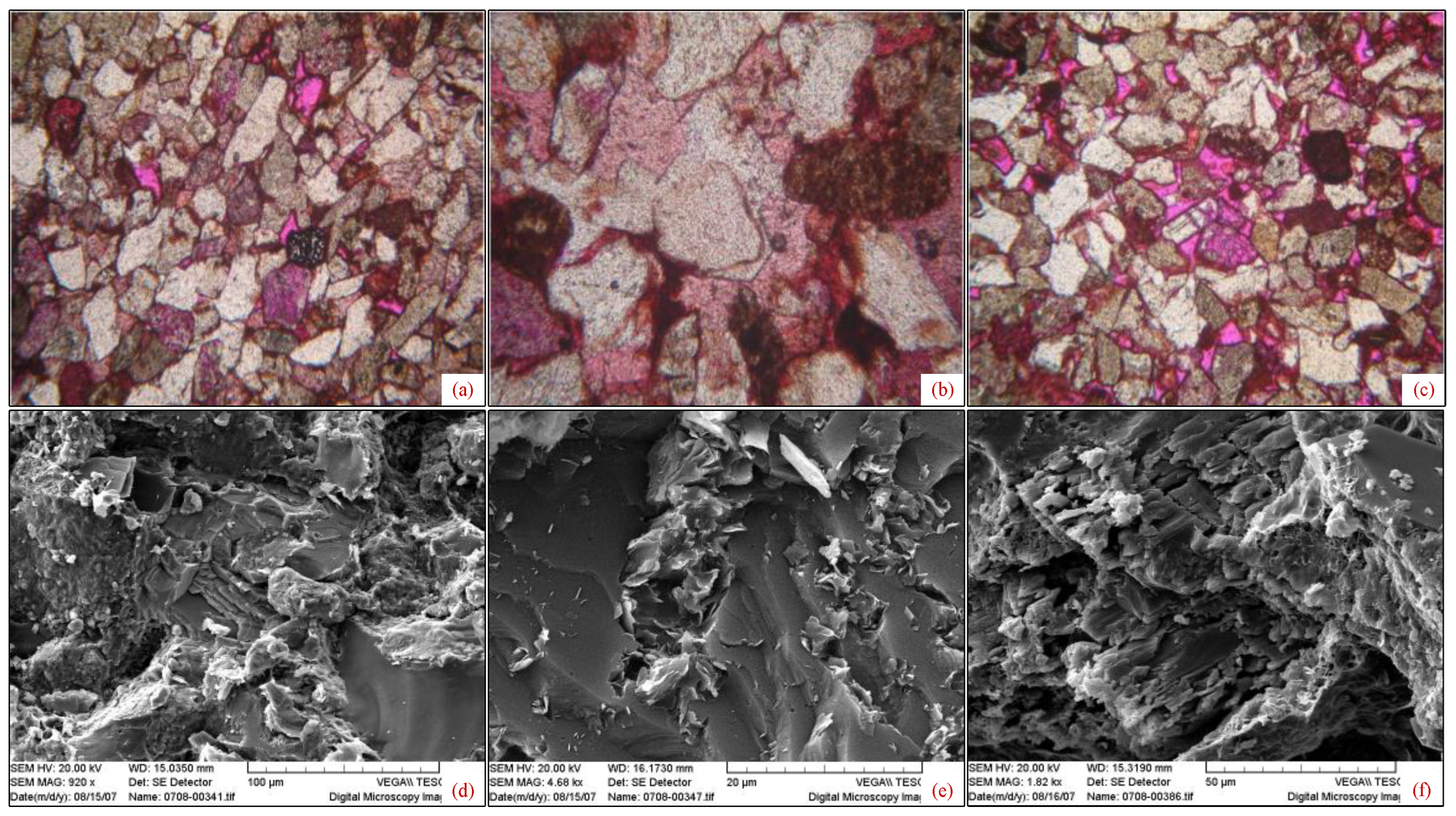

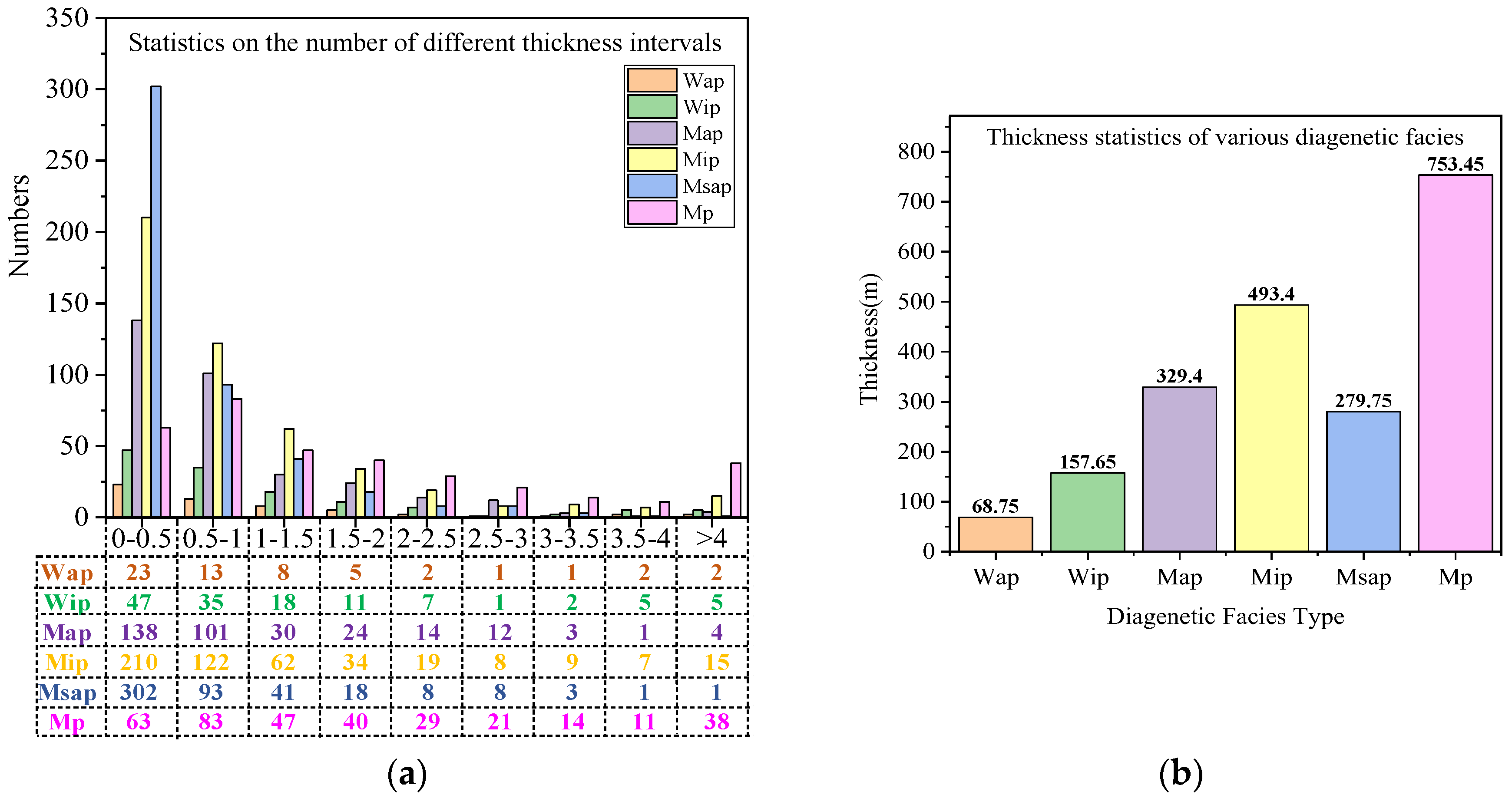

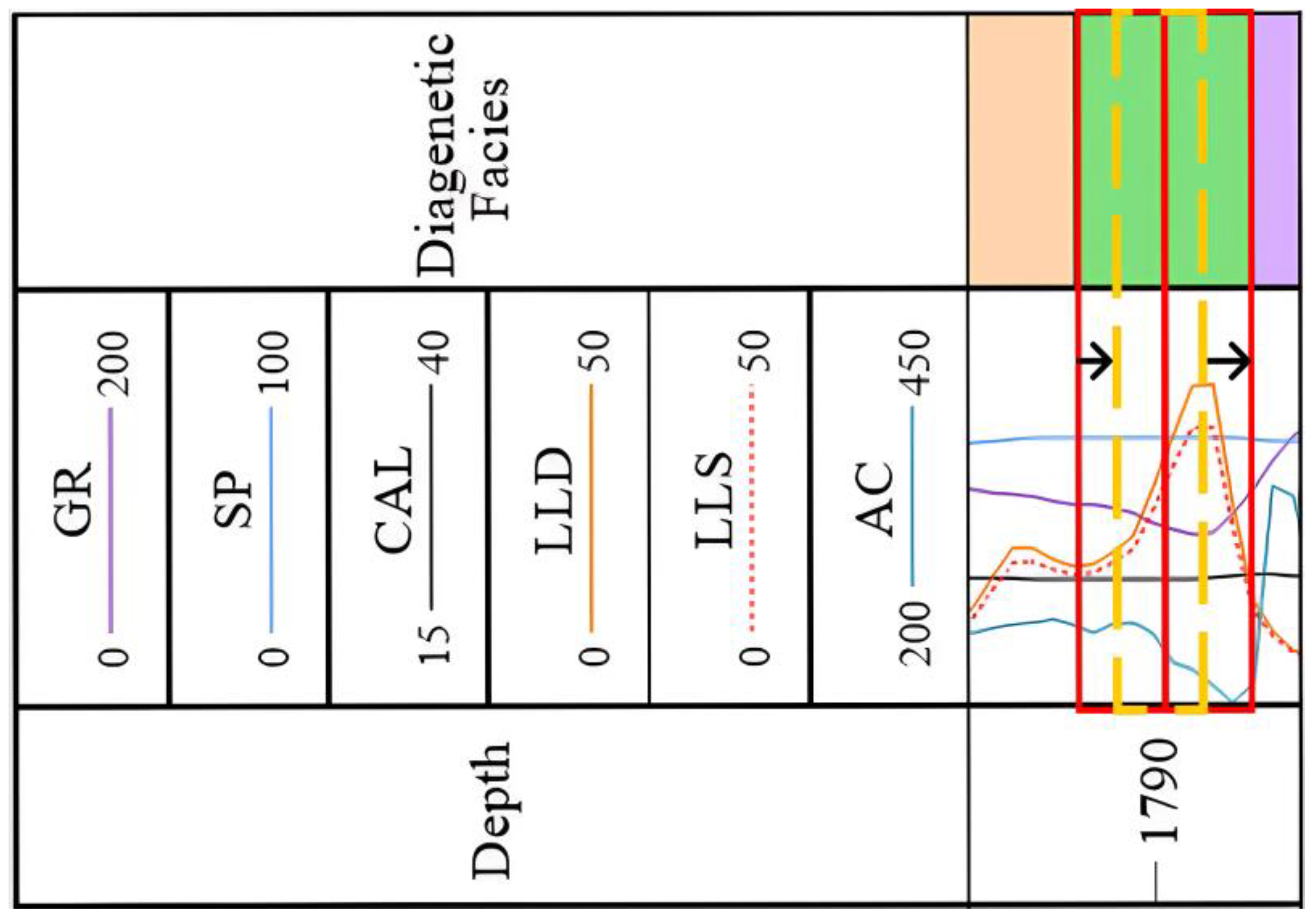


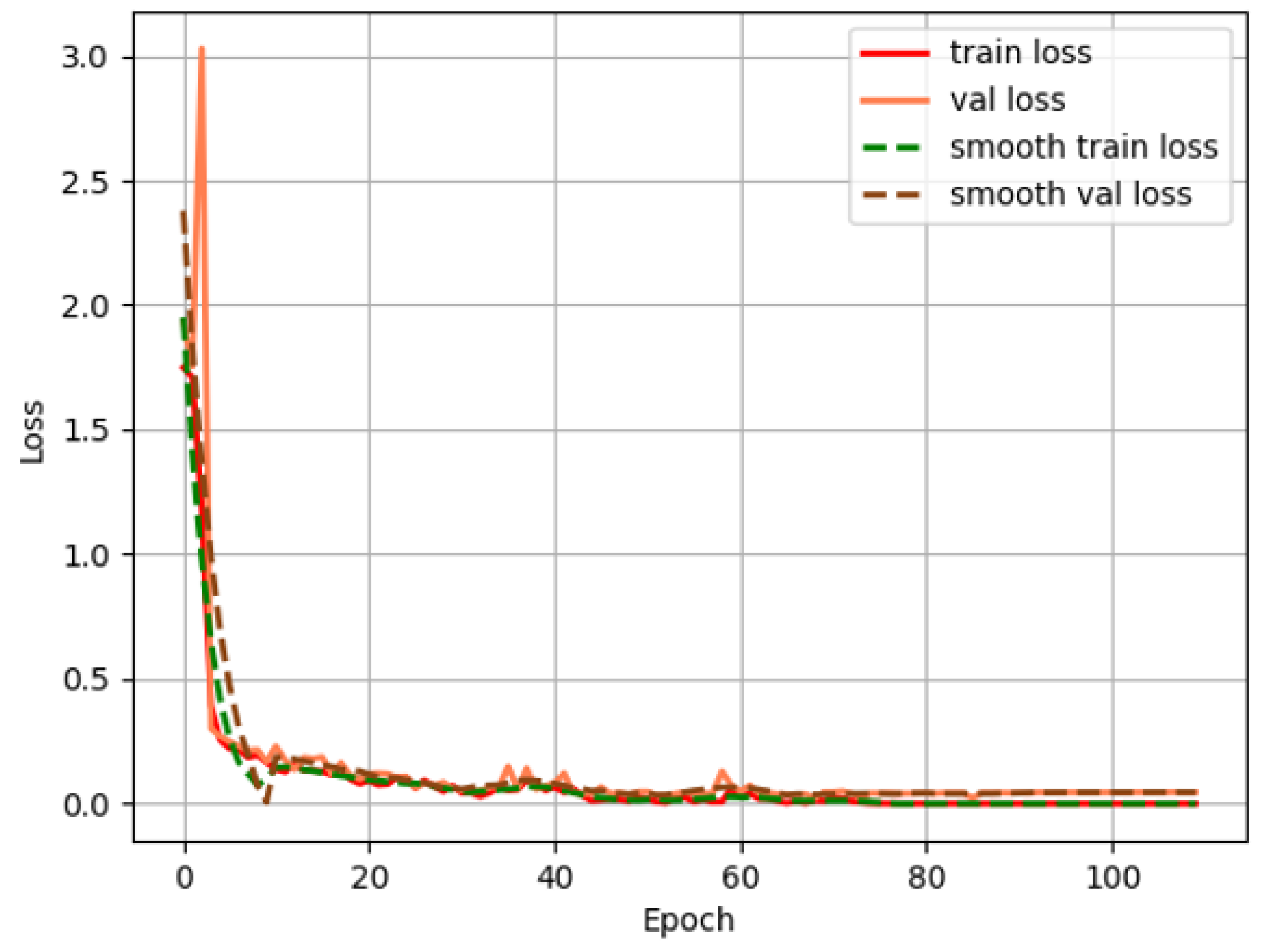



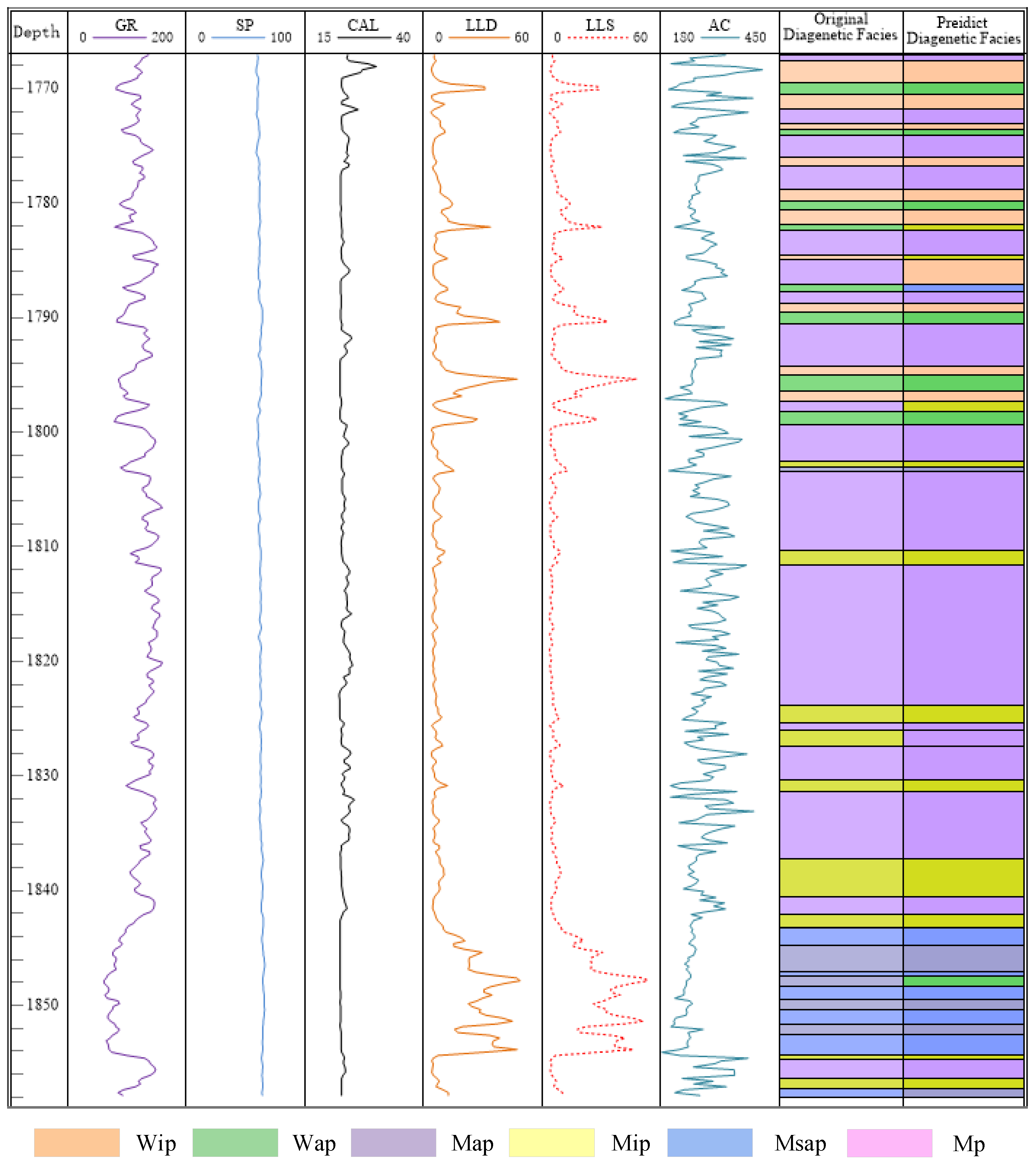
| Order | Well | Coring Depth (m) | Length (m) | Order | Well | Coring Depth (m) | Length (m) | ||
|---|---|---|---|---|---|---|---|---|---|
| Top | Bottom | Top | Bottom | ||||||
| 1 | B7 | 1872.700 | 2081.100 | 208.40 | 16 | F464 | 1835.039 | 1939.989 | 104.95 |
| 2 | B17 | 1858.025 | 2043.475 | 185.45 | 17 | H23-6 | 1800.020 | 1831.170 | 31.15 |
| 3 | B18 | 1836.001 | 2139.951 | 303.95 | 18 | S52 | 1719.000 | 1872.000 | 153.00 |
| 4 | B102 | 1914.500 | 1963.400 | 48.90 | 19 | S541 | 1818.025 | 1946.975 | 128.95 |
| 5 | B183 | 1895.012 | 1906.962 | 11.95 | 20 | S55 | 1754.000 | 1793.950 | 39.95 |
| 6 | B211 | 1775.000 | 1792.550 | 17.55 | 21 | X18 | 1943.025 | 2021.975 | 18.95 |
| 7 | B351 | 1982.981 | 2021.181 | 38.20 | 22 | X21 | 2182.000 | 2228.000 | 46.00 |
| 8 | BF59-51 | 1720.690 | 1854.940 | 134.25 | 23 | X23 | 2068.000 | 2138.000 | 70.00 |
| 9 | F13 | 1787.300 | 1998.800 | 211.50 | 24 | X141 | 2030.000 | 2095.981 | 69.95 |
| 10 | F27 | 1755.125 | 1843.125 | 88.00 | 25 | Z11 | 1810.000 | 2004.700 | 194.70 |
| 11 | F29 | 1843.000 | 1875.000 | 32.00 | 26 | Z22 | 1695.800 | 1798.900 | 103.10 |
| 12 | F98-16 | 1760.000 | 1870.950 | 110.95 | 27 | Z43-251 | 1800.030 | 1861.830 | 61.80 |
| 13 | F186-16 | 1920.040 | 2024.990 | 104.95 | 28 | Z43-251-1 | 1800.009 | 1876.959 | 76.95 |
| 14 | F188-138 | 1767.100 | 1858.050 | 90.95 | 29 | Z43-261 | 1800.049 | 1885.999 | 85.95 |
| 15 | F361 | 1765.325 | 1890.475 | 125.15 | 30 | Z44-251 | 1773.950 | 1880.900 | 106.95 |
| Diagenetic Facies | Longitudinal Thickness Unit Interval | |||
|---|---|---|---|---|
| 0.50 (m) | 0.75 (m) | 1.00 (m) | 1.25 (m) | |
| Wip | 267 | 151 | 97 | 72 |
| Wap | 110 | 64 | 45 | 31 |
| Map | 442 | 242 | 150 | 105 |
| Mip | 768 | 449 | 290 | 194 |
| Msap | 364 | 183 | 114 | 70 |
| Mp | 1342 | 831 | 587 | 439 |
| Diagenetic Facies | Longitudinal Thickness Unit Interval | |||
|---|---|---|---|---|
| 0.50 (m) | 0.75 (m) | 1.00 (m) | 1.25 (m) | |
| Wip | 600 | 150 | 95 | 70 |
| Wap | 525 | 150 | 110 | 80 |
| Map | 440 | 240 | 150 | 105 |
| Mip | 765 | 445 | 290 | 190 |
| Msap | 515 | 180 | 110 | 70 |
| Mp | 570 | 235 | 150 | 105 |
| Diagenetic Facies | ||||||
|---|---|---|---|---|---|---|
| Wip | Wap | Mip | Map | Msap | Mp | |
| Jaccard | 0.78 | 0.74 | 0.75 | 0.74 | 0.81 | 0.91 |
Disclaimer/Publisher’s Note: The statements, opinions and data contained in all publications are solely those of the individual author(s) and contributor(s) and not of MDPI and/or the editor(s). MDPI and/or the editor(s) disclaim responsibility for any injury to people or property resulting from any ideas, methods, instructions or products referred to in the content. |
© 2024 by the authors. Licensee MDPI, Basel, Switzerland. This article is an open access article distributed under the terms and conditions of the Creative Commons Attribution (CC BY) license (https://creativecommons.org/licenses/by/4.0/).
Share and Cite
Liu, T.; Liu, Z.; Zhang, K.; Li, C.; Zhang, Y.; Mu, Z.; Liu, F.; Liu, X.; Mu, M.; Zhang, S. Intelligent Identification Method for the Diagenetic Facies of Tight Oil Reservoirs Based on Hybrid Intelligence—A Case Study of Fuyu Reservoir in Sanzhao Sag of Songliao Basin. Energies 2024, 17, 1708. https://doi.org/10.3390/en17071708
Liu T, Liu Z, Zhang K, Li C, Zhang Y, Mu Z, Liu F, Liu X, Mu M, Zhang S. Intelligent Identification Method for the Diagenetic Facies of Tight Oil Reservoirs Based on Hybrid Intelligence—A Case Study of Fuyu Reservoir in Sanzhao Sag of Songliao Basin. Energies. 2024; 17(7):1708. https://doi.org/10.3390/en17071708
Chicago/Turabian StyleLiu, Tao, Zongbao Liu, Kejia Zhang, Chunsheng Li, Yan Zhang, Zihao Mu, Fang Liu, Xiaowen Liu, Mengning Mu, and Shiqi Zhang. 2024. "Intelligent Identification Method for the Diagenetic Facies of Tight Oil Reservoirs Based on Hybrid Intelligence—A Case Study of Fuyu Reservoir in Sanzhao Sag of Songliao Basin" Energies 17, no. 7: 1708. https://doi.org/10.3390/en17071708
APA StyleLiu, T., Liu, Z., Zhang, K., Li, C., Zhang, Y., Mu, Z., Liu, F., Liu, X., Mu, M., & Zhang, S. (2024). Intelligent Identification Method for the Diagenetic Facies of Tight Oil Reservoirs Based on Hybrid Intelligence—A Case Study of Fuyu Reservoir in Sanzhao Sag of Songliao Basin. Energies, 17(7), 1708. https://doi.org/10.3390/en17071708






